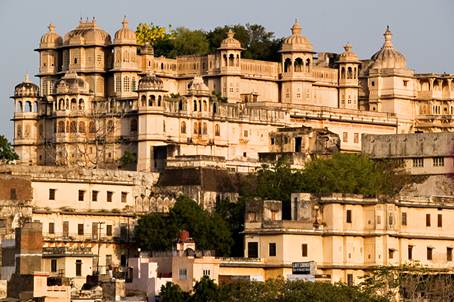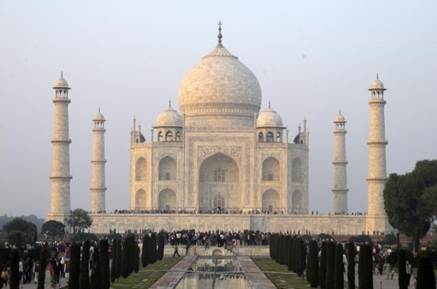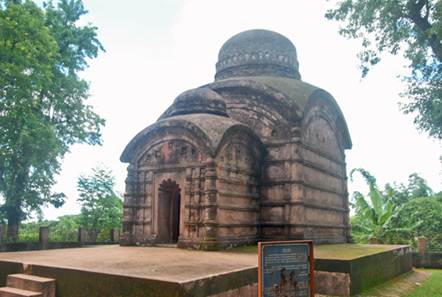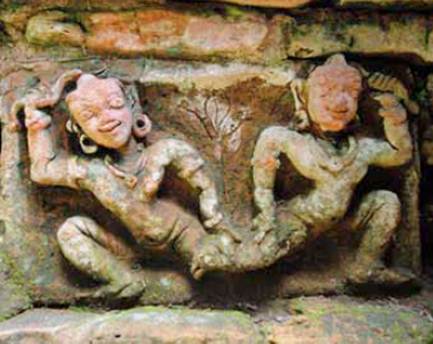But then, the Manikya kings who ruled Tripura for nigh on
six hundred years until 1949 were of tribal origin themselves. The officially
sanctioned Rajmala, a genealogical history of the Tripura kings posited a lunar
line for the ruling family, linking it to the Mahabharata. However, the first
ruler of this clan who can be placed with any certainty was a tribal king of
possibly Arakan extraction called Cheong-pha, who replaced the ruling Deva
family of eastern Bengal and Tripura in the fifteenth century, successfully
defended his new territory against the reigning sultans of upper Bengal and
took on the Sanskritised monarchical suffix ‘Manikya’.

Udaipur, the old
capital of the Manikya kingdom, was once known as Rangamati
Udaipur, the old capital of the Manikya kingdom, was once
known as Rangamati. Today, it is a bustling city dotted by massive old lakes
(or dighis) and equally old temples of great grace and beauty. The Manikyas
were great builders, and they were highly influenced by current styles of Bengali
architecture, peppered liberally with Islamic motifs and the older tradition of
Buddhist stupas. Udaipur has old temples in every corner, although there are
some eleven major ones grouped around different parts of the city. The most
famous and revered one is, of course, that of Tripura’s patron goddess,
Tripurasundari. We went to Matabari, as it is popularly known, on a Monday
evening. The bright red building of the 500-year-old temple, gleaming in the
setting sun, cast a blood-red aura around itself. Built in 1501 by one of the
most illustrious kings of Tripura, Dhanya Manikya, this Tantric Kali temple is
a classic example of Tripuri architecture a typically Bengali char chaala or
four-roofed structure, surmounted with a Buddhist stupa like crown. People were
lining up for the darshan of an old Tantric Kali idol, which was reputedly
brought by the king from Chittagong. This is an important shakti peetha like
Kamakhya in Guwahati, and is the centre of the shakti cult of the mother
goddess in Tripura. Tripurasun-dari is also a part of the tribal pantheon,
known in the native Kok Borok language as Hakwcharmama, one of the main
benevolent deities after Matai Katar.

The Archaeological
Survey of India
If Tripurasundari is still feted, many others have fallen
into disuse. The beautiful group of three temples called the Gunabati guchcha
(bunch) were built by the king Govindya Manikya for his wife Gunabati in 1668.
These are under the ambit of the Archaeological Survey of India and therefore
well maintained, but two more creations of this king’s reign his palace and a
beautiful red Vishnu temple, both on the north bank of the Gomati have gone to
seed spectacularly.

the Bhuvaneshwari
temple
The old palace, and its neighbouring temple, the
Bhuvaneshwari, is quite famous as the setting for Rabindranath Tagore’s novella
from 1887, Rajarshi, and his dramatic adaptation of it, Bisarjan, from 1890.
The Manikya kings, starting with Birchandra Manikya, had a long and interesting
relationship with Tagore. They were his benefactors, especially his friend
Radha Kishore Manikya, who paid Tagore an annual income, and even financed the
Visva Bharati University in Santiniketan. When the penultimate king built a
lavish water palace for himself on Rudrasagar lake in west Tripura, it was
Tagore who was asked to name it. He called it Neermahal. Tagore, on his part,
loved Tripura, travelling there many times and staying for a while.
In part this was possible due to the long cultural contact
and extensive geographical contiguity between Bengal and Tripura before 1947.
Two things brought this home to me. The first was the dargah of one of the four
famous Sufi pirs of Bengal, Badruddin Badri-i-Alam, better known as Shah Badar,
who passed through Bengal and Tripura on his way to Arakan and back in the
fifteenth century, and his followers set up dargahs in his memory across the
region. On the south bank of the Gomati in Udaipur lies one such, called Badar
Mokam, dating to sometime in the seventeenth century, also built in the char
chaala style as the temples, only without the Buddhist-style dome. Badar is
also the patron saint of majhis (boatmen or sailors), and quite characteristically
his dargah stands near the ferry-ghat on the Gomati, home to many fishermen.

A terracotta
plaque found at the Pilak excavation site
The other contact is even older, and to see it we travelled
south from Udaipur to the town of Jolaibari in south Tripura The unassuming
village of Pilak was once the site of an extensive Buddhist civilisation that
stretched all the way from Nalanda in Bihar to Pagan in Burma. This region of
Tripura and the adjoining areas of Comilla and Noakhali in present day
Bangladesh were at various points under the kingdoms of Samatata, Harikela and
Pattikera from at least the fifth century AD till the twelfth century. In the
middle of a picture-perfect rural landscape of rice fields and hillocks lay the
excavation sites of Shyamsundar Tila, Pujakhol Tila and Thakurani Tila.